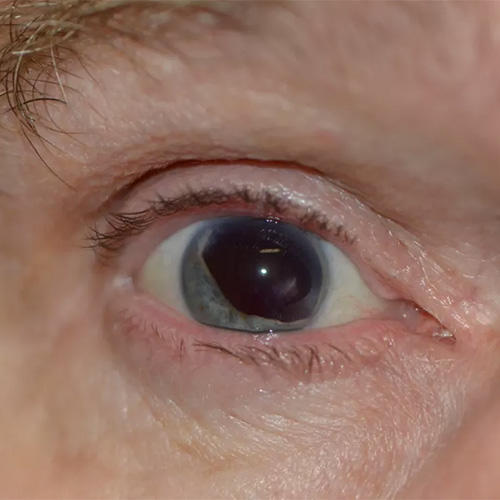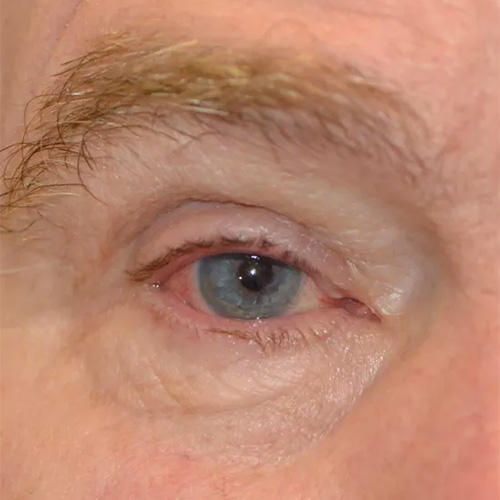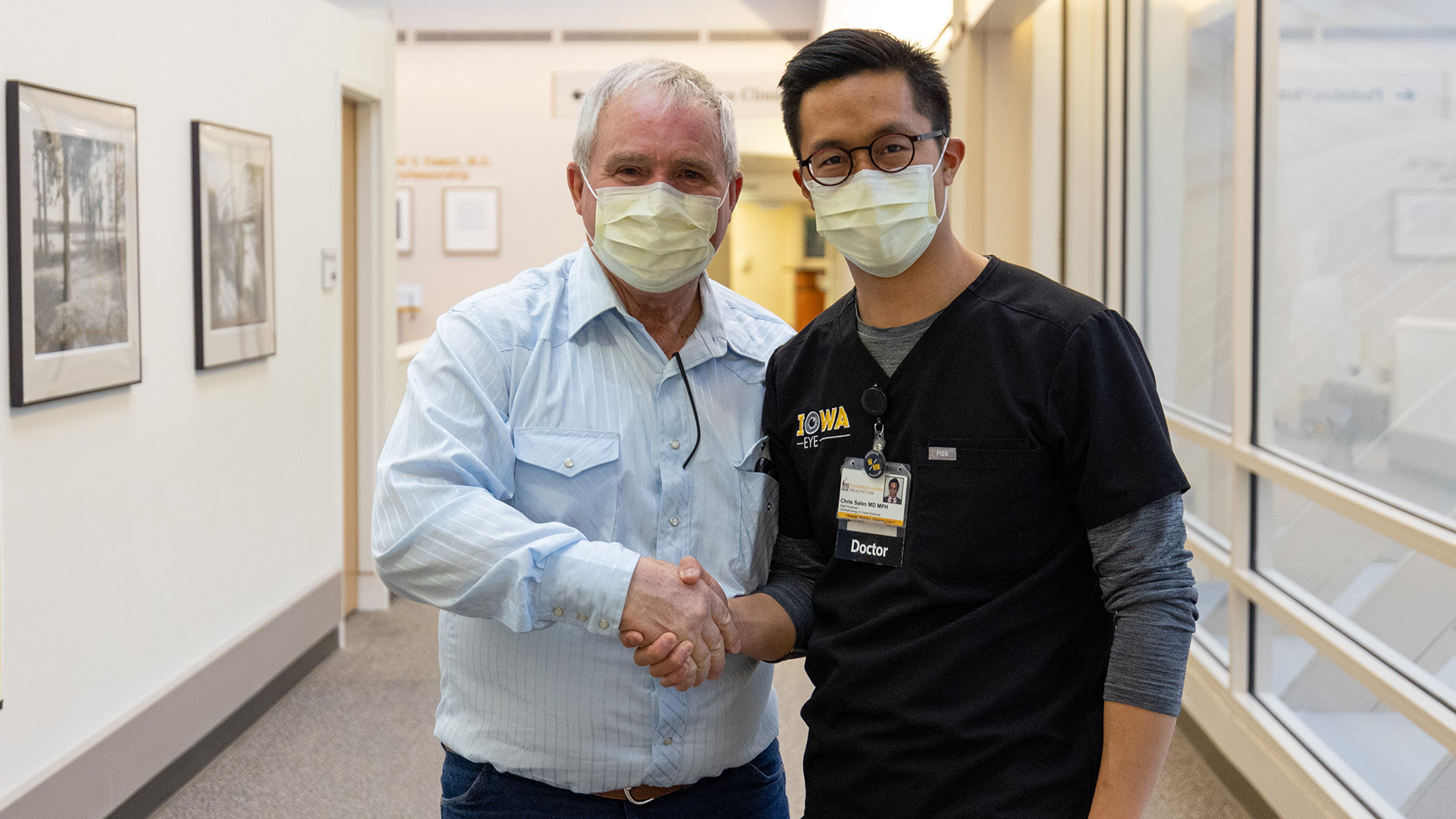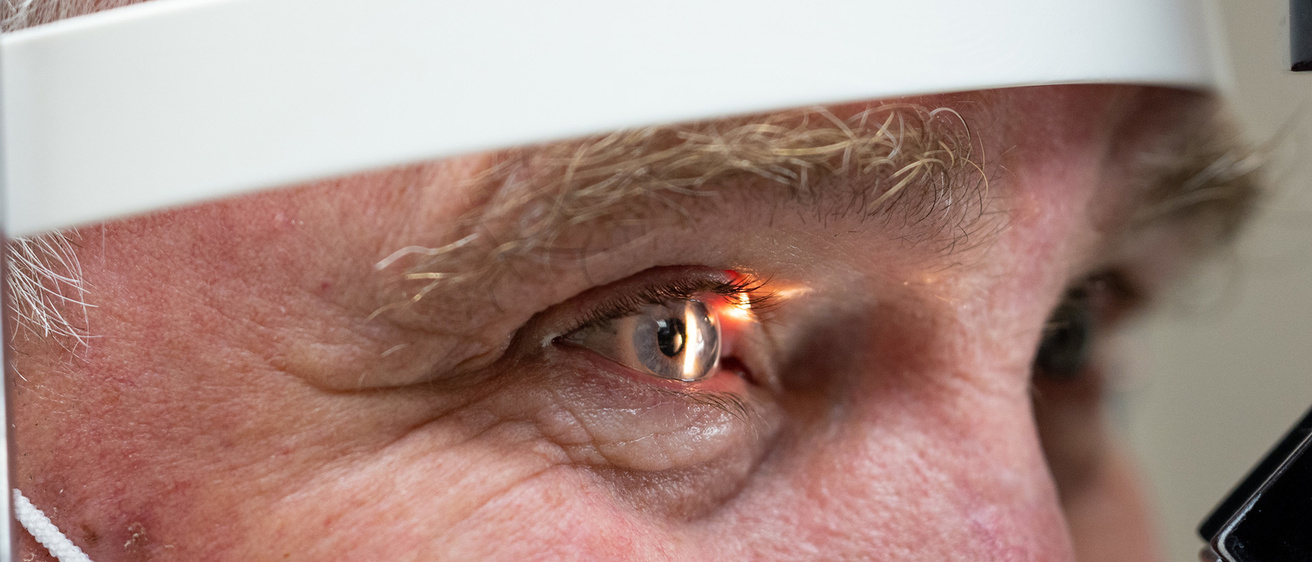Following Larry Molyneux’s eye injury, surgeons at University of Iowa Health Care performed an artificial iris implant using advanced technology. The What Cheer, Iowa, man’s vision has improved and his eye looks natural.
Story: Molly Rossiter
Photography: Carlos Herriott II
Published: Jan. 9, 2023
After a sliver of steel went through Larry Molyneux’s right eye, the 68-year-old What Cheer, Iowa, man wasn’t sure he’d be able to keep the eye, let alone ever see again.
But thanks to an artificial iris implant done by surgeons at University of Iowa Hospitals & Clinics using new technology—as well as a bit of fate that prevented the steel from damaging the optic nerve—Molyneux can not only see, but his injured eye looks like it was never injured at all.
Leading the way with advancements in eye care
Although artificial iris implants have been around for decades, until recently only a handful of places across the country were able to perform the procedure. It wasn’t until 2018 that the first iris prosthesis was approved for use in the United States.
Molyneux is the first patient in Iowa to receive this new, human-like silicone prosthetic iris.
“This is a significant advance in technology,” says Christopher Sales, MD, MPH, an ophthalmologist and surgeon at UI Health Care Medical Center who performed Molyneux’s surgery. “Early implants didn’t look human—they helped with vision but significantly affected the appearance of the patient’s eye.”
The new human-like silicone implant is custom made using images of the patient’s healthy iris. Once manufactured it is a carbon copy of the healthy eye. Because of its silicone flexibility, surgeons are able to implant the iris through an incision roughly one-tenth of an inch long and with very little suturing.
“That’s not to say it’s an easy surgery; I’m folding an iris that is about the size of a cornea, which is about four times the size of the incision,” Sales says. “It’s tough to do, but it’s really beneficial for the patient. It’s a minimally invasive surgery with a faster recovery time.”
Seeing red: trauma to the eye
Molyneux was helping his nephews change tracks on a bulldozer in early February 2021 when he felt something hit his eye. He typically wears a pair of reading glasses when doing close work, but the inside of the machine shop was getting warm and his glasses kept slipping off his nose.
“I finally just took them off my nose and it wasn’t 10 seconds later a piece of steel came up and went right into my eye,” he says. He remembers the sting of pain but didn’t know yet that the steel was inside his eye.
His nephews loaded him into a truck and planned to take him to a local hospital, but when the truck hit a snowdrift Molyneux’s view of the world turned red.
“I turned to my nephew and told him I felt like I was looking through a window pane covered in blood,” Molyneux says.

Larry Molyneux’s right eye before the procedure (above) and after the implant was performed (below).

They altered their route and headed to UI Health Care Medical Center where within hours surgery was done first to repair the injury to the eye and remove the steel. Surgeons discovered the steel had narrowly missed the optic nerve, which meant Molyneux could possibly regain vision in that eye. First, though, the wound would need to heal, which meant his iris would remain damaged, compromising his vision.
Living with light sensitivity
The iris is the colored part of the eye surrounding the pupil, the small black opening that lets light in. The pupil is controlled by the muscles in the iris – when the pupil is wider more light gets in; when it’s smaller, less light is allowed in. The eye needs an aperture – a pupil – to block most of the light to which the eye is exposed. Without the iris, too much light comes in. When there is damage to the iris, or there is no iris, the pupil can’t function as it should and too much light is allowed through the eye.
Molyneux’s damaged iris was barely visible, and his pupil was very large.
“A good analogy is like trying to have a conversation in a loud coffee shop,” Sales explains, “there’s just too much noise. The same is true of light – when there’s too much ‘noise’ vision is poor and there is light sensitivity.”
With Humanoptics the artificial iris looks real, unlike previous models that appeared almost robotic. The Humanoptics model is also flexible, allowing it to pass through a much smaller incision and allow for faster healing.
For the patient, Sales says, the biggest benefit is being able to walk outside without the glare of high-intensity light.

“I’m not going to tell you it’s perfect, but I went through a year of not being able to see out of that eye, I learned to walk with one eye open. And now I can see. I have peripheral vision. I can do a lot more than I could before.”
‘I can do a lot more’
In the year that passed between Molyneux’s initial repair surgery and getting his iris implant, he tried everything to keep the light out of his eye. He used patches, towels, bandages, and more, to no avail. He had to stop working with his nephews because he couldn’t be outside. Having lost his depth perception and his innate sense of level, operating a bulldozer and walking on uneven terrain also was difficult.
Molyneux received his iris implant in September 2022. He noticed an immediate difference.
“Since the surgery, I can now be out in daylight without dark glasses and that eye doesn’t bother me any more than the other eye,” he says. “On a scale of 1 to 10, my vision before the surgery was a 1 or 2. Now it’s probably a 6 or 7, and we can get it better with some glasses.”
His vision is better, too. Before surgery he said he could see a difference between light and dark and could make out shapes. Now, he says, he can read and write with ease, and watch his grandchildren play. Walking, working, operating equipment, and even relaxing have all improved significantly.
“I’m not going to tell you it’s perfect, but I went through a year of not being able to see out of that eye, I learned to walk with one eye open,” he says. “And now I can see. I have peripheral vision. I can do a lot more than I could before.”
That’s the outcome Sales was hoping for.
“This is one of the most gratifying surgeries I get to do,” he says. “Until you put in a prosthetic, these people are really sensitive to light, they can’t be outside on a bright day. And then you do the surgery and take the patch off the next day and they’re amazed, it’s a whole lot better. And it really is amazing.”
Sales acknowledges he would never have been able to perform Molyneux’s surgery had it not been for the ophthalmologists at UI Health Care who came before him. Thomas Oetting, MD, MS, and A. Tim Johnson, MD, PhD, were involved in clinical trials for earlier iris prosthetic devices.
“They helped pave the way,” says Sales. “That’s one of the great parts of working at an academic medical center; we can provide patients with access to the latest advances in research and technology that can make a meaningful difference in their quality of life.”
One of the best
UI Health Care has one of the top ophthalmology programs in the country, ranked #7 by “U.S. News & World Report.”
